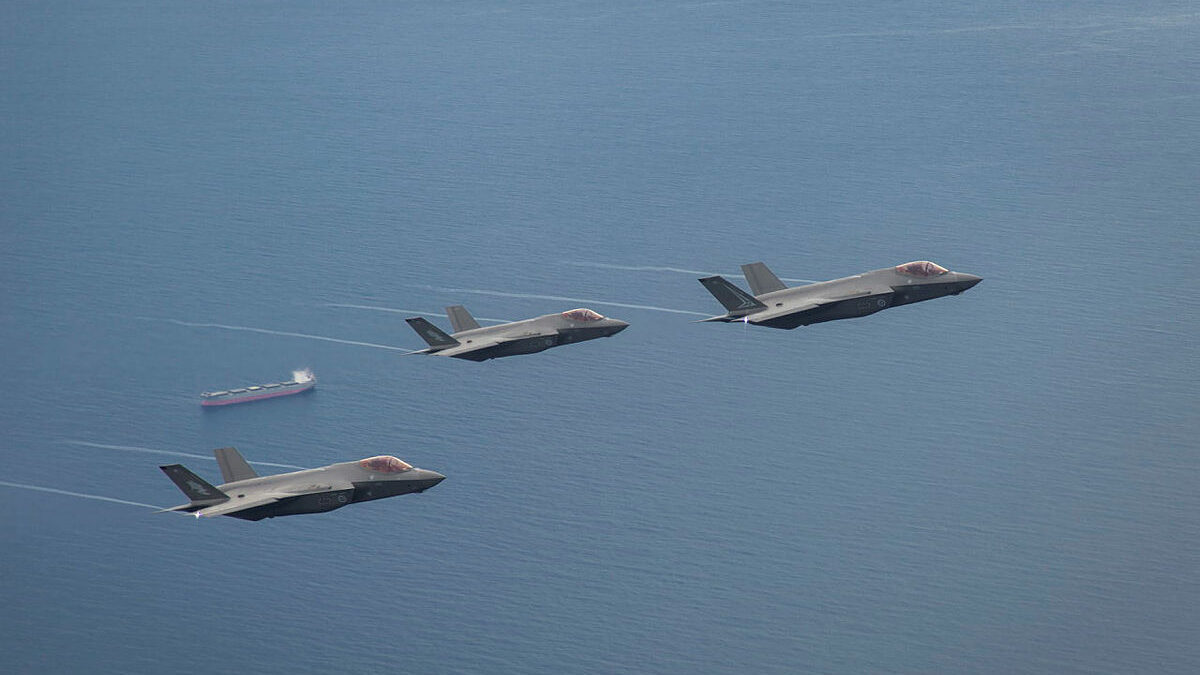
F-35 Lightning II aircraft from RAAF Base Williamtown fly of the coast of Newcastle on Nov. 23, 2020. (Australian Air Force)
WASHINGTON: Over the last four years the United States’ arms exports, led mostly by aircraft sales, were more than double that of Russia, the world’s second largest exporter, according to the Stockholm International Peace Research Institute.
A new SIPRI report published today compares data from sales conducted between 2012-2016 against purchases from 2017-2021, showing a significant jump in US sales between those periods.
“The growth in US arms exports between [the two four-year periods] was largely due to increases in arms exports to Saudi Arabia, Australia, South Korea and Japan – the four main recipients of US arms exports in 2017-21,” according to the report.
RELATED: Congress settles on $782.B national defense budget, adds $13.6B in Ukraine aid
“Aircraft were the USA’s main arms export [in the past four years], making up 62 percent of its total arms exports, followed by missiles (17 percent) and armoured vehicles (10 percent),” according to SIPRI. Specifically, SIRPI pointed to the pricey but popular F-35 and the planned delivery of some 600 of that aircraft to customer nations.
For a sense of scale, in the last year three years the US has averaged about $47 billion in government programs and another $114.1 billion in sales from US industry firms to foreign buyers, according to the Defense Security Cooperation Agency.
Russia’s and China’s exports — the latter of whom is the fourth biggest global exporter — continued to fall, similar to trends seen in last year’s report. Meanwhile France, the world’s third biggest seller, rose by 59%, the researchers found.
SIPRI found Russia’s drop in sales could be traced mostly to decreases in buys from old customers India and Vietnam.
Between 2012–16 and 2017–21 French🇫🇷 arms exports increased⬆️ by 59%, while Chinese🇨🇳 (–31%), Russian🇷🇺(–26%) and German🇩🇪 (–19%) decreased⬇️.
New SIPRI data on trends in international #ArmsTransfers available now ➡️ https://t.co/qJHF1cJLWM pic.twitter.com/gEz6JBRdNa
— SIPRI (@SIPRIorg) March 14, 2022
But India was overall the world’s largest arms importer, even though its imports dropped from the previous timeframe, followed by Saudi Arabia and Egypt. Between 2017 and 2021, India saw several Russian programs wind down while simultaneously spinning up sales from France, resulting in a tenfold increase in overall spending between the Indians and the French.
RELATED: Next US defense budget will get a boost due to Ukraine invasion: Pentagon comptroller
The sales were driven by “perceived growing threats from China and Pakistan and because of significantly delays in the production of its own major arms,” according to SIPRI. “The drop in India’s arms imports [11% from 14% globally] is … probably a temporary result of its slow and complex procurement process as well as its shift in suppliers.”
Who were the five largest arms importers in 2017–21?
1) India🇮🇳
2) Saudi Arabia🇸🇦
3) Egypt🇪🇬
4) Australia🇦🇺
5) China🇨🇳Together, they received 38% of total global arms imports in 2017–21. New SIPRI data on global #ArmsTransfers out now ➡️ https://t.co/mwH3tzOOIM pic.twitter.com/aWA5s4Fac8
— SIPRI (@SIPRIorg) March 14, 2022
Other notable points:
- Australia’s imports rose by 62%, driven mostly by sales from the US, making it the fourth largest importer globally.
- Overall, European states increased spending by 19% compared to previous years led by the United Kingdom, Norway and the Netherlands.
- Despite many Gulf region states increasing arms imports due to the conflict in Yemen, the UAE’s purchases dropped in recent years by 41%, “taking it from the third largest to the ninth largest arms importer globally,” according to SIPRI.
Sullivan says Ukraine supplemental should cover all of 2024, long-range ATACMS now in Ukraine
“We now have a significant number of ATACMS coming off their production line and entering US stocks,” Jake Sullivan said today. “And as a result, we can move forward with providing the ATACMS while also sustaining the readiness of the US armed forces.”


























